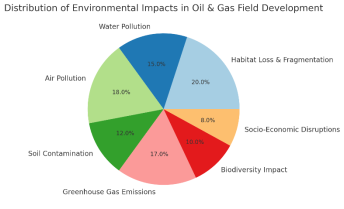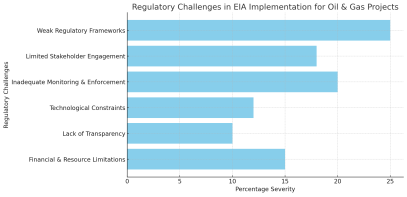The development of oil and gas fields is a complex process with significant potential for environmental disruption. This paper examines the critical role of Environmental Impact Assessment (EIA) in mitigating these impacts throughout the lifecycle of such projects. The study explores the key components of an effective EIA, including the identification of potential environmental consequences, the evaluation of their significance, and the development of mitigation measures. Furthermore, it analyzes the challenges and opportunities associated with implementing EIAs in the oil and gas sector, considering factors such as regulatory frameworks, stakeholder engagement, and technological advancements.
Introduction
The global demand for energy continues to drive the exploration and development of oil and gas resources. These activities, while crucial for meeting energy needs and fueling economic growth, carry substantial environmental risks. Oil and gas field development projects, encompassing exploration, drilling, production, transportation, and eventual decommissioning, can lead to a wide array of environmental impacts. These impacts can range from habitat destruction and biodiversity loss to air and water pollution, soil contamination, greenhouse gas emissions, and social disruptions. Recognizing the potential for such significant environmental consequences, Environmental Impact Assessment (EIA) has become an indispensable tool for ensuring responsible and sustainable development in the oil and gas sector.
EIA is a systematic process of evaluating the potential environmental effects of a proposed project or development. It aims to identify, predict, and assess the likely environmental consequences of a project and propose measures to mitigate or minimize adverse impacts before they occur. The core principles of EIA include early integration into project planning, consideration of a wide range of environmental factors, public participation and consultation, and the development of environmental management and monitoring plans. In the context of oil and gas field development, EIA plays a crucial role in informing decision-making processes, guiding project design and implementation, and ultimately contributing to the long-term environmental sustainability of operations.
The oil and gas industry presents unique challenges for EIA due to the scale and complexity of its projects, the often remote and ecologically sensitive locations of resource extraction, and the potential for both short-term and long-term environmental effects.
Materials and methods
This research will employ a qualitative research approach, primarily relying on a comprehensive review of existing literature, including peer-reviewed journal articles, industry reports, government publications, and international guidelines related to Environmental Impact Assessment in the oil and gas sector. The literature review will focus on identifying key environmental impacts associated with oil and gas field development projects, the methodologies and approaches used in EIA for these projects, the challenges and best practices in implementing EIA, and the role of regulatory frameworks and stakeholder engagement.

Fig. 1. Distribution of key environmental impacts in oil and gas field development projects
Case studies of oil and gas development projects from various geographical locations will be analyzed to provide practical examples of the application of EIA and its effectiveness in mitigating environmental impacts. These case studies will be selected based on the availability of detailed EIA reports and post-project environmental monitoring data. The analysis of case studies will aim to identify common environmental concerns, successful mitigation strategies, and lessons learned that can inform future EIA practices.
Furthermore, this research will examine relevant environmental regulations and guidelines at both national and international levels to understand the legal and policy context of EIA in the oil and gas industry. This will involve reviewing the EIA requirements of key regulatory bodies and international organizations involved in environmental protection and oil and gas development.

Fig. 2: Regulatory challenges in implementing Environmental Impact Assessments (EIA) for oil and gas projects
The data collected from the literature review and case study analysis will be synthesized and analyzed thematically to identify key trends, challenges, and best practices in the application of EIA in oil and gas field development projects. The analysis will focus on addressing the research objectives, which include understanding the critical role of EIA, identifying key environmental consequences, evaluating the significance of these consequences, and exploring mitigation measures and challenges in implementation.
Results
The results of this research, based on the literature review and analysis of case studies, indicate several key findings regarding the application of Environmental Impact Assessment in oil and gas field development projects. The literature consistently highlights a wide range of potential environmental impacts associated with these projects, including habitat loss and fragmentation, water and air pollution, noise pollution, soil contamination, greenhouse gas emissions, impacts on biodiversity, and socio-economic disruptions. The severity and extent of these impacts can vary depending on the specific characteristics of the project, the location, and the environmental safeguards implemented.
Discussion
The findings of this research underscore the critical role of Environmental Impact Assessment in addressing the significant environmental challenges associated with oil and gas field development projects. The wide range of potential impacts identified in the literature and illustrated in case studies highlights the inherent risks involved in these activities. The effectiveness of EIA as a tool for mitigating these risks is contingent upon a multitude of factors, emphasizing the need for a holistic and rigorous approach.
Conclusion
Environmental Impact Assessment is an indispensable tool for managing the environmental risks associated with oil and gas field development projects. This research has highlighted the wide range of potential environmental impacts of these projects and underscored the critical role of a comprehensive and transparent EIA process in mitigating these impacts. The effectiveness of EIA depends on its early integration into project planning, the quality of the assessment, the level of stakeholder engagement, the robustness of mitigation measures, and the effectiveness of monitoring and enforcement.
References:
- Glasson, J., Therivel, R., & Chadwick, A. (2019). Introduction to environmental impact assessment. Routledge.
- Morgan, R. K. (2012). Environmental impact assessment: The state of the art. Impact Assessment and Project Appraisal, 30(1), 5–14. https://doi.org/10.1080/14615517.2012.661557

